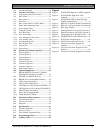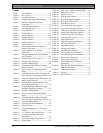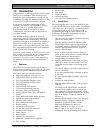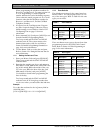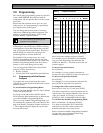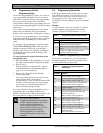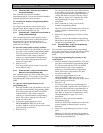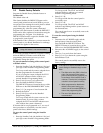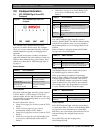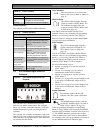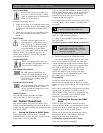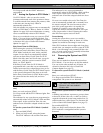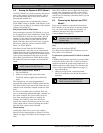
ICP-CC404 | Installation Guide | 2.0 Programming
Bosch Security Systems, Inc. | 12/08 | F01U089401-02 13
2.4.7 Command 964 – Erase the Programming
Key
This command erases all data from the programming
key. You can only use the CC891 Programming Key
with the ICP-CC404 Control Panel.
To erase the programming key:
1. Enter the Installer Code (the default is 1234) and
press [#] to enter Installer’s Programming Mode.
Two beeps sound and the STAY and AWAY
indicators flash on the remote codepad to
indicate you entered Installer’s Programming
Mode. The remote codepad shows the data
stored in Location 000.
2. Connect the programming key to the
PROGRAMMING KEY pins (next to the
Auxiliary Module socket) at the top of the control
panel’s printed circuit board.
3. Enter [9 6 4 #].
Two beeps sound after the data is deleted.
4. Enter [9 6 0 #] to exit from the Installer’s
Programming Mode.
The STAY and AWAY indicators turn off on the
remote codepad to indicate that the system is
disarmed.
5. Remove the programming key from the control
panel.
Failing to exit from the Installer’s Programming
Mode before removing the programming key can
corrupt the programming key.
2.4.8 Command 965 – Set Up Domestic Dialing
Format
Command 965 simplifies the setup of the domestic
dialing format to a one-step operation. Refer to Section
9.0 Domestic Dialing on page 40 for more information.
To set up domestic dialing format:
1. Enter the Installer Code (the default is 1234) and
press [#] to enter Installer’s Programming Mode.
Two beeps sound and the STAY and AWAY
indicators flash on the remote codepad to
indicate you entered Installer’s Programming
Mode. The remote codepad shows the data
stored in Location 000.
2. Enter [9 6 1 #].
The command automatically sets Receiver 1 to
domestic reporting and sets the locations shown
in bold in Table 6 on page 14 for Receiver 2 only.
No other locations are changed when you issue
Command 965.
All domestic telephone numbers are stored in
Locations 466 to 513. For more information, refer to
Section 9.2 Setting Up and Programming Domestic
Reporting on page 41.
As shown in Table 6 on page 14, the transmission
format is automatically set for domestic dialing and
the Subscriber ID Number set for one identification
beep. All reports, except Zone Status reporting and
System Status reporting, are allocated to Receiver 1
for domestic dialing.
Zone Status Reports, including Zone Bypass, Zone
Trouble, Sensor Watch, and Alarm Restore codes,
and System Status Reports, including AUX Power
Supply Fail, AC Fail, Low Battery, and Access
Denied Reports, are allocated to Receiver 2 and do
not report unless Receiver 2 is also set up to report.
2.4.9 Command 966 – Enable or Disable Auto
Step Mode
This command allows you to enable or disable Auto
Step Mode when programming in Installer’s
Programming Mode. When programming with the
remote codepad, there is no visual indication that
Auto Step Mode is enabled.
If the Auto Step Mode is enabled, pressing [*]
automatically moves you to the next programming
location.
If Auto Step Mode is disabled, you must move to the
next location by pressing [#]. The example below
shows that Auto Step Mode is very useful when
programming successive locations.
To enable Auto Step Mode:
1. Enter the Installer Code (default = 1234) and
press [#] to enter Installer’s Programming Mode.
Two beeps sound and the STAY and AWAY
indicators flash on the remote codepad to show
you entered Installer’s Programming Mode. The
remote codepad displays the data stored in
Location 000.
2. Enter [9 6 6 #].
Two beeps sound.
To disable Auto Step Mode:
Enter [9 6 6 #].
Two beeps sound.



